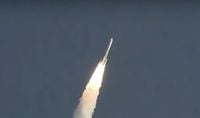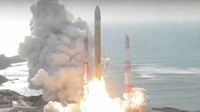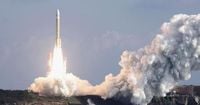Japan has taken another bold step in its pursuit of space leadership with the successful launch of the HTV-X1 cargo spacecraft atop the country’s most powerful H3 rocket, marking a pivotal moment for both national space ambitions and international cooperation. The launch, which took place on October 26, 2025, from the Tanegashima Space Center in southern Japan, was confirmed by the Japan Aerospace Exploration Agency (JAXA) and widely reported by outlets including AP, Space.com, and SpaceNews.
The HTV-X1 spacecraft separated from the No. 7 H3 rocket and was placed into its planned orbit just 14 minutes after liftoff. According to JAXA, this mission is not just a routine delivery run but a showcase of new technology and capability, as the HTV-X1 is the first of a new generation of cargo vehicles designed to support the International Space Station (ISS) and potentially, future lunar missions.
"A major step forward" is how JAXA President Hiroshi Yamakawa described the launch, emphasizing Japan’s growing capability for autonomous space activity. The enthusiasm was echoed by Iwao Igarashi, head of the Space Business Department at Mitsubishi Heavy Industries, who noted that Japan’s record of on-time launches and accuracy in payload delivery demonstrates the country’s readiness to meet a diverse range of customer needs. Mitsubishi Heavy Industries, which developed the H3 rocket with JAXA, plans to expand its launch facilities in response to the successful mission.
The HTV-X1 is scheduled to arrive at the ISS in just a few days, with Japanese astronaut Kimiya Yui—currently aboard the station—set to capture the spacecraft using the station’s robotic Canadarm2 in the early hours of October 30, 2025. The craft will be berthed to the Harmony module, joining a stable of international cargo vehicles that includes Russia’s Progress, Northrop Grumman’s Cygnus, and SpaceX’s Dragon. Notably, only Dragon is reusable; the HTV-X, like its peers, is designed to burn up in Earth’s atmosphere upon mission completion.
The HTV-X is a direct successor to JAXA’s H-II Transfer Vehicle, known as Kounotori (“White Stork”), which completed nine missions to the ISS between 2009 and 2020. The new freighter, however, represents a significant leap forward in capability. At 26.2 feet (8 meters) long, the HTV-X is about four feet shorter than its predecessor, but it can carry a payload of roughly 6,000 kilograms (about 13,200 pounds)—a 50% increase over the original HTV. This includes four tons of pressurized cargo and two tons of unpressurized cargo, with the latter now mounted on the top of the spacecraft to maximize capacity.
One of the standout features of the HTV-X is its ability to supply power during flight, which is crucial for transporting sensitive cargo such as cells and laboratory samples that require low-temperature storage. The spacecraft is also equipped with deployable solar arrays—rather than the body-mounted panels used on the old HTV—which produce 50% more power, further enhancing its utility for extended missions. The pressurized module itself boasts 60% more volume than its predecessor, allowing for more flexible cargo arrangements.
For its debut mission, HTV-X1 is carrying about 4.5 tons of cargo, including essential space station hardware, scientific experiments, and six cubesats that will be deployed from the airlock of the ISS’s Kibo module. The craft is designed to remain docked at the ISS for up to six months, delivering supplies and collecting waste. After its duties at the station are complete, HTV-X1 will spend approximately three months in low Earth orbit conducting technology demonstrations. These will include releasing a cubesat, testing a laser retroreflector, and deploying a structure with a flat-panel antenna and solar cells to test technologies for future space-based solar power systems.
Japan’s ambitions for the HTV-X extend well beyond the ISS. According to JAXA and Space.com, the agency envisions future versions of the spacecraft supporting post-ISS human activities in low Earth orbit and possibly delivering cargo to NASA’s planned lunar Gateway as part of the Artemis program. At least three HTV-X missions to the ISS are already planned, and proposals for lunar Gateway logistics are under active consideration.
The launch also marked the debut of the H3 rocket’s most powerful configuration, featuring four solid rocket boosters and a larger payload fairing. This new flagship model replaces Japan’s venerable H-2A rocket, which completed its final flight in June 2025. The H3 is designed to offer a more cost-competitive platform for global space missions, and its reliability is increasingly evident: after a failed maiden flight in 2023, the H3 has now achieved six consecutive successful launches.
Japan’s government and industry leaders see a stable and commercially competitive space transport capability as essential not just for the country’s space program, but also for national security. As AP and SpaceNews report, the ability to reliably deliver supplies to space underpins autonomous space activity and enhances Japan’s standing in the increasingly crowded and competitive space sector.
The HTV-X’s arrival increases the number of operational ISS cargo craft by one-third, reinforcing international cooperation aboard the station and ensuring the flow of supplies and scientific equipment remains robust. While the HTV-X is not reusable, its enhanced payload, flexible mission profile, and advanced technology make it a formidable addition to the ISS supply chain.
Looking to the future, the HTV-X program holds promise not only for continued support of the ISS but also for Japan’s strategic ambitions in lunar exploration and beyond. Whether it’s delivering science experiments, supporting human crews, or demonstrating new technologies in orbit, the HTV-X is poised to play a central role in Japan’s space endeavors for years to come.
With this successful launch, Japan has signaled its readiness to compete on the world stage, and the HTV-X’s journey has only just begun.


